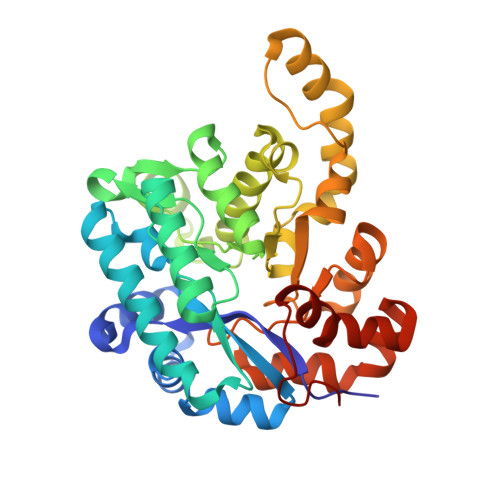Structural Basis of Salicylic Acid Decarboxylase Reveals a Unique Substrate Recognition Mode and Access Channel.
Gao, X., Wu, M., Zhang, W., Li, C., Guo, R.T., Dai, Y., Liu, W., Mao, S., Lu, F., Qin, H.M.(2021) J Agric Food Chem 69: 11616-11625
- PubMed: 34553918
- DOI: https://doi.org/10.1021/acs.jafc.1c04091
- Primary Citation of Related Structures:
6JQW, 6JQX - PubMed Abstract:
Salicylic acid (SA) decarboxylase from Trichosporon moniliiforme (TmSdc), which reversibly catalyses the decarboxylation of SA to yield phenol, is of significant interest because of its potential for the production of benzoic acid derivatives under environmentally friendly reaction conditions. TmSdc showed a preference for C2 hydroxybenzoate derivatives, with k cat / K m of SA being 3.2 × 10 3 M -1 s -1 . Here, we presented the first crystal structures of TmSdc, including a complex with SA. The three conserved residues of Glu8, His169, and Asp298 are the catalytic residues within the TIM-barrel domain of TmSdc. Trp239 forms a unique hydrophobic recognition site by interacting with the phenyl ring of SA, while Arg235 is responsible for recognizing the hydroxyl group at the C2 of SA via hydrogen bond interactions. Using a semi-rational combinatorial active-site saturation test, we obtained the TmSdc mutant MT3 (Y64T/P191G/F195V/E302D), which exhibited a 26.4-fold increase in k cat / K m with SA, reaching 8.4 × 10 4 M -1 s -1 . Steered molecular dynamics simulations suggested that the structural changes in MT3 relieved the steric hindrance within the substrate access channel and enlarged the substrate-binding pocket, leading to the increased activity by improving substrate access. Our data elucidate the unique substrate recognition mode and the substrate entrance tunnel of SA decarboxylase.
Organizational Affiliation:
Key Laboratory of Industrial Fermentation Microbiology of the Ministry of Education, College of Biotechnology, Tianjin University of Science and Technology, No. 29, 13th Avenue, Tianjin 300457, China.
















